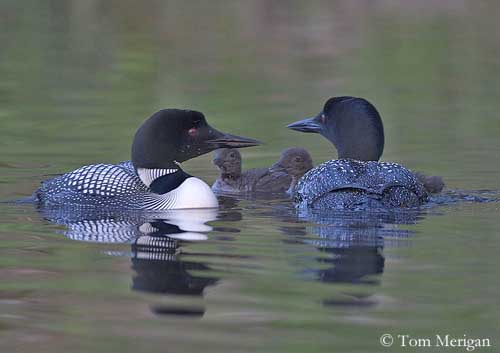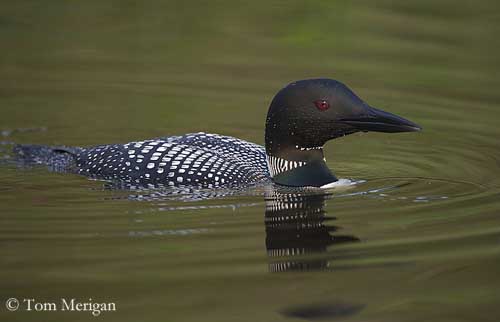
Fr: Plongeon imbrin
All: Eistaucher
Esp: Colimbo Grande
Ital: Strolaga maggiore
Nd: Ijsduiker
Sd: Svartnäbbad islom
Photographers :
Tom Grey
Tom Grey's Bird Pictures
Tom Merigan
Tom Merigan’s Photo Galleries
Bob Moul
Nature Photography
Text by Nicole Bouglouan
Sources:
HANDBOOK OF THE BIRDS OF THE WORLD vol 1 by Josep del Hoyo-Andrew Elliot-Jordi Sargatal - Lynx Edicions - ISBN: 8487334105
FIELD GUIDE TO THE BIRDS OF NORTH AMERICA - National Geographic Society - ISBN: 0792274512
Animal Diversity Web (University of Michigan Museum of Zoology)
Bird Web (Seattle Audubon Society)
What Bird-The ultimate Bird Guide (Mitchell Waite)
Wikipedia (Wikipedia, The Free Encyclopedia)
Common Loon or Great Northern Diver
Gavia immer
Gaviiforme Order – Gaviidae Family
BIOMETRICS:
Length: 69-90 cm
Wingspan: 127-147 cm
Weight: 2780-4480 g
DESCRIPTION:
The Common Loon is famous in extreme North America and Canada, for its calls which can be heard running over the lakes, as coming from anywhere.

The Common Loon adult in breeding plumage is black and white. Both adults are similar, with male larger than female.
Head and neck are black with green gloss, and we can see a fine black and white line between the chin and the throat, and two conspicuous white patches with fine black vertical bars on the neck sides.
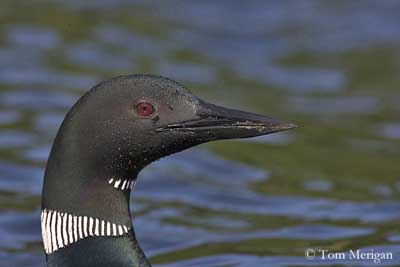
Upperparts show black and white pattern. Back and scapulars are black heavily spotted white. Upperwing is blackish, finely spotted white except on the flight feathers. Tail is black.
Underparts are pure white.

The black bill is straight and heavy. Eyes are deep red. Legs and webbed feet are black.
In winter plumage, adult is brownish-grey above, with dark crown and nape. Underparts are white. The bill is rather greyish or paler with dark culmen.
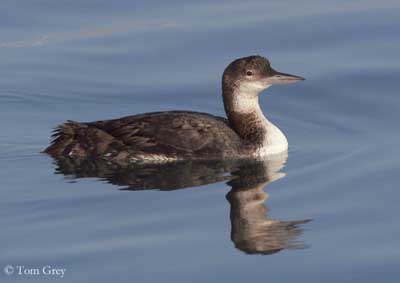
Chicks are brownish with brown eyes.
Juvenile resembles adult in non-breeding plumage, but we can see some buffy scaling on the upperparts.
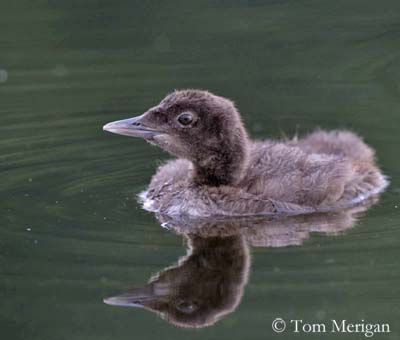

VOICE: SOUNDS BY XENO-CANTO
The Common Loon gives loud yodelling calls all year round, but mainly during the breeding season. This call is used by the male to proclaim that the territory is occupied, and is similar to high-pitched whistle interspersed with clear notes.
Alarm call is a strident tremulous laugh.
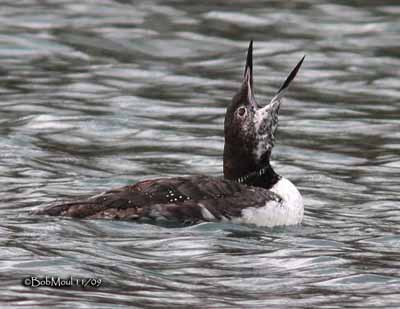
We can also hear a long wailing call as territorial signal, and a low-pitched moaning as contact call between adults and young, also given by males while mating.
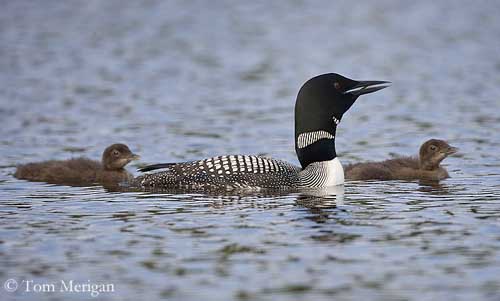
HABITAT:
The Common Loon breeds on large deep freshwater lakes, in open tundra or near coniferous forest according to the range. But it usually nests on islets.
During winter, this species is found along coasts, as well rocky headlands as in sheltered bays, and even occasionally inland, in ice-free bodies of water.
RANGE:
The Common Loon breeds in the northernmost parts of North America, in Canada, northern US, Greenland an Alaska, with a small population in Iceland.
It winters over wide range in Europe and British Isles, and of course in North America.

BEHAVIOUR:
The Common Loon feeds primarily on fish of various species, and also takes crustaceans, molluscs, aquatic invertebrates and amphibians. It may consume some plant matter such as aquatic vegetation, shoots, roots, seeds, moss and algae.
It hunts under water by diving, and pursues the prey. It is able to dive until 60-70 metres depth, but usually between 4 and 10 metres, and during about one minute.
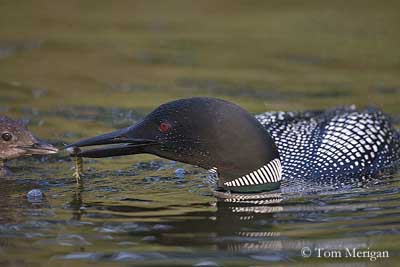
The Common Loon is territorial and performs some defence displays. An aggressive and intense territorial display is used during disputes and against intruders. The loon adopts an upright posture, often with open wings and flapping them. This display usually follows a long rush over the water surface. Fights are not frequent but they can be violent, with the use of bill and wings.
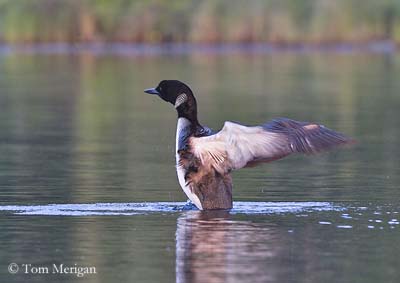
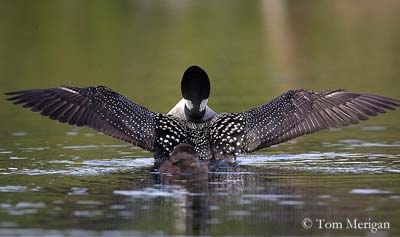
Courtship displays are simpler and less spectacular. Both mates perform mutual “bill-dipping”, “splash-diving” and “rushing” under water. The female adopts a pre-copulatory posture on the shore, crouching motionless or pecking repeatedly. Copulation occurs on the shore and several times until the eggs have been laid.
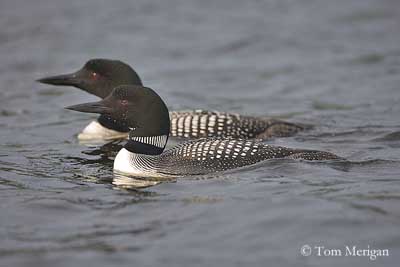
The Common Loon is migratory, moving southwards after breeding. They shun the frozen and ice-covered water. They migrate singly or in small groups of about 15 birds.
Outside the breeding season, the Common Loons gather in large flocks in rich feeding areas. They roost and feed together. They roost on the water except during the breeding season during which it occurs on land.
FLIGHT:
The Common Loon is heavy and requires long-distance running over water to take off. When it lands on the water, it extends the legs and the webbed feet forwards to skid along the surface. It swims very well and dives easily.
It is able to travel long distances during the migrations, flying swiftly with the neck outstretched while calling, uttering “beautiful, mystical and enchanting tremolo”.
The flight is rapid and direct, with strong deep wing-beats.
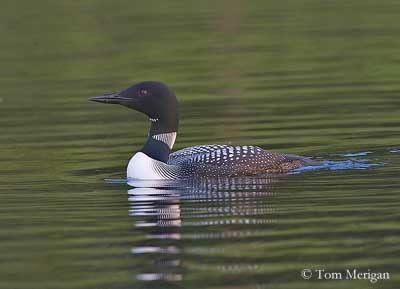
REPRODUCTION:
Breeding season varies according to the range. The Common Loon is monogamous and pairs probably spend the winter together.
It is solitary nester and breeds in forested lakes and ponds. The nest is a heap of vegetation situated close to the water’s edge, and often on islets.
Female usually lays two eggs. Incubation lasts 24-25 days, shared by both parents, but mainly by female. The larger chicks obtain most of the food brought by parents, and the younger chick often dies in a few days.
They are able to swim and dive very soon after hatching. Then, they leave the nest and are often seen swimming or resting on adults’ backs. They fledge 70-77 days after hatching and are sexually mature at two years. Parents feed them until they are fully-grown.
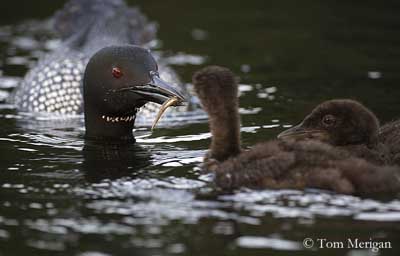
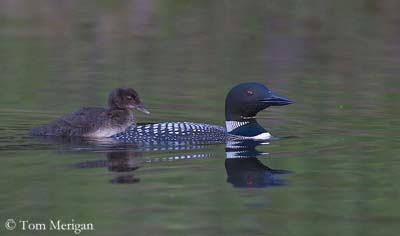
DIET:
The Common Loon feeds mainly on fish (cod, haddock, herring, trout, suckers, minnows and perch), some crustaceans, molluscs, aquatic insects, annelids, frogs and some other amphibians. It also takes plant matter (pondweeds, willow shoots, seeds, moss and algae).
PROTECTION / THREATS / STATUS:
The Common Loon populations are not globally threatened, but numbers have decreased steadily in the south of the range.
They are vulnerable to human disturbances and pollution of the water. They also have predators of eggs and chicks such as gulls and corvids, small mammals and large fish. Adults are preyed upon by Bald Eagles and large marine mammals.
